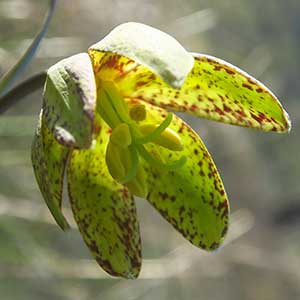Fritillaria glauca
Fritillaria recurva
Siskiyou fritillaria, Siskiyou fritillary, Siskiyou missionbells
red bells, scarlet fritillary
large 3–9; small 1–9.
large 6; small 20–30.
0.8–2 dm.
3–9 dm.
2–4, alternate, 3.5–9 cm;
blade lanceolate-oblong, sickle-shaped, glaucous.
in 1–3 whorls of 2–5 leaves per node proximally, alternate distally, 3–15 cm;
blade linear to narrowly lanceolate.
nodding;
tepals purplish or greenish marked with yellow, lanceolate-oblong, 1.5–2.5 cm, apex not recurved;
nectaries green with maroon dots, broadly lanceolate, less than 1/2 tepal length;
style obviously branched for 1/2 its length, branches longer than 1.5 mm.
nodding;
perianth slender;
tepals scarlet, checkered with yellow adaxially and purple abaxially, 1.5–3.7 cm, apex usually strongly recurved;
nectaries yellow, narrowly lanceolate, 1/4 tepal length or less;
style obviously branched for 1/4–1/2 its length, branches ± erect, longer than 1.5 mm.
broadly winged.
winged.
= 24.
= 24, 36.
Fritillaria glauca
Fritillaria recurva
Variety coccinea has been recognized by a number of authors, but examination of numerous specimens indicates no consistent distinction. In some cases, different plants from the same population appear to align with different varieties.
The Shasta and Yana tribes used Fritillaria recurva bulbs as food.
(Discussion copyrighted by Flora of North America; reprinted with permission.)


